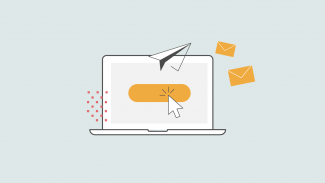Reactivate, re-engage, and win-back with our email examples
What is a win-back email? Unlike a lot of things in the business space - which can be full of jargon that’s difficult to understand - this term does exactly what it says on the tin.
It’s all about re-engaging email subscribers, bringing back previous members and reactivating those who have dropped off your radar with the goal of converting them into paid-up members once more.
Having a clear and coherent plan in place for your reactivation emails is really important, otherwise, your membership list could look a bit like a leaky bucket: no matter how hard you fill it up, there’s always a percentage of members who leave with the end result of no net gain in numbers.
Essentially, you want to reach out to members with something so tantalising that they can’t help but give you their hard-earned cash once more.
That all sounds wonderful in principle, but in practise there’s a lot more that goes into it. Remember, these people will have cancelled for a reason, right? It’s up to you to show them the error of their ways without being pushy or condescending.
A quick win in this regard would be to create a member-exit feedback form that captures why they decided to pull the plug. This could serve two purposes:
- It can help you know how to retarget them
- You can improve your offering based on feedback
How to create a great win-back campaign

Did you know that only 35% of organisations will try and win-back their members? That means you’re already doing something right by thinking about ways to re-engage email subscribers, so well done you!
One of the first steps to creating a fantastic win-back campaign is to give the person a little bit of breathing space. Don’t go in all guns blazing the second they hit that cancel button, because the chances are you won’t know their motivation behind it.
Wait a few days, allow that time for reflection and then send that email that reminds the former user why they signed up in the first place.
That can all be done with good old human intuition, but to create a really good set of win-back emails, you’re going to need something a little more robotic.
We’re talking marketing automation here. It can do a whole lot of good, and streamline processes that were previously cumbersome.
Re-engage email subscribers
We spoke a little bit about giving old members some breathing space, and you can definitely do that manually. However, you can also do it with more speed and less hassle by employing smart Timer, Wait for Event or Check Profile nodes in your marketing automation workflow to make sure you’re not spamming people’s inboxes.
When someone leaves the snug embrace of your membership business, you can automatically target them through intelligent segments.
Segments can be created that house your inactive member profiles, and a reactivation email flow can be triggered each time a new profile drops into that segment.
If you have different types of inactive members, you can always create a dedicated flow for each profile. That’s the beauty of marketing automation!
Plan your next three emails
That next step would be to plan for at least three emails. Why three? The chances that one will be read is slim, but some gentle and persuasive persistence means that email two or three will have more chance of being successful. In fact, up to 50% of old members are likely to engage with the second or third email.
These emails could go a little something like this:
- People like to feel valued and missed, so tell them how much you miss them! Try to pull on those heartstrings to get that member to subscribe again.
- In your second email, you could show off all the great things that have happened while that person has been away!
- Your third email could show off all the compelling stuff that’s coming up in the future, which should really give them a reason to come flooding back to you.
Remember, you’ve gotta keep these win-back emails engaging. That means offer some discount codes, maybe a killer percentage off a yearly membership, or if you’re a B2B enterprise you could send along a free whitepaper or a webinar invite.
When all of that has been put in place, you also need the email to look good. That means it’s important to invest in a tool that’ll allow you to create lovely looking messages that conform to your brand identity. Luckily, Apsis One has just the thing for all of that!
Killer strategy examples

There are a few good examples from the world of membership out there, so here are a few to get your creative juices flowing.
Use humour
Some campaigns don’t have to emphasise the value members can gain, rather you can add a splash of humour to things and create good-looking emails.
Showcase your convenience
People like to do things that are easy. We don’t want any more hassle in our lives, especially not when it comes to doing something optional. So in your email, it would be a good idea to reassure people that rejoining would be simple, easy and won’t carry the commitment that might scare some people off.
Broadcast your value
In contrast to the two other examples, you can remind former members about the value they’re missing out on. You could be a union that tries to recoup lapsed members by reminding them about all the good stuff you’ve done within the industry. Don’t be shy, shout about your success!
Win-back emails don’t have to cost the earth
We’ve seen that your win-back campaign doesn’t have to be the most complicated thing in the world, but it will need to include some magic ingredients:
- Use data to automatically drop old members into a segment that targets them with your re-engagement strategy.
- Remember to make them feel special and that means personalisation!
- Dream up three good emails to send that’s guaranteed to show your old member the fun they’re missing out on
- And don’t be afraid to use a bit of humour to spark a connection that might last a lifetime.
Email marketing is the lifeblood of any organisation, and there are far more facets to it than just win-back campaigns. Luckily, Apsis have gathered all the best brains in the business in this email handbook. Download it here!


